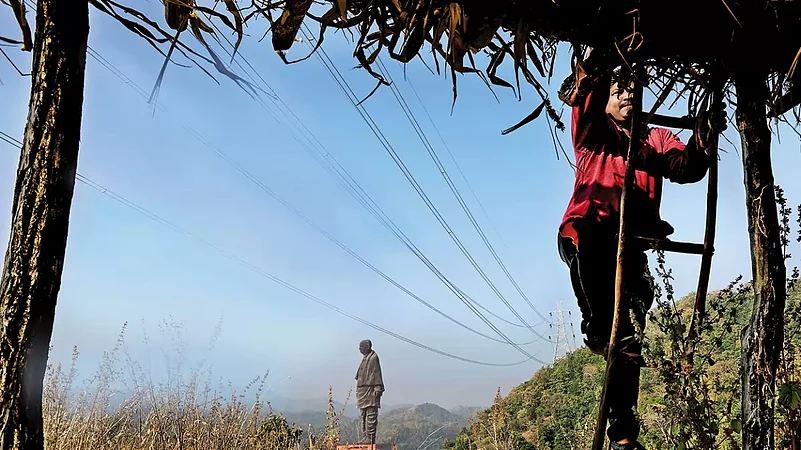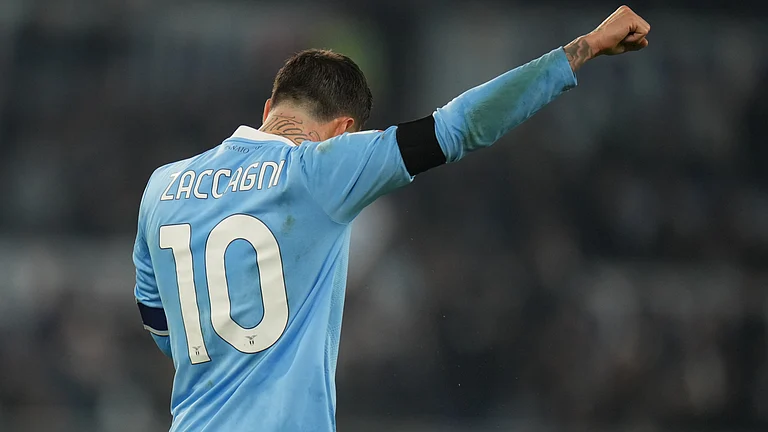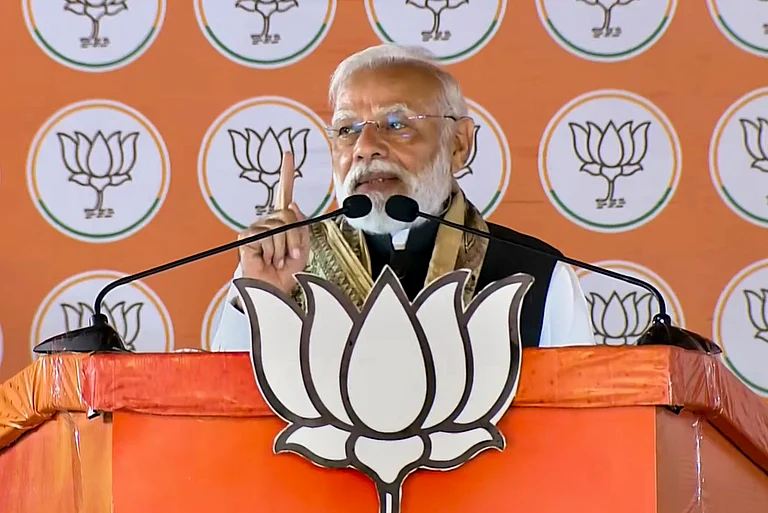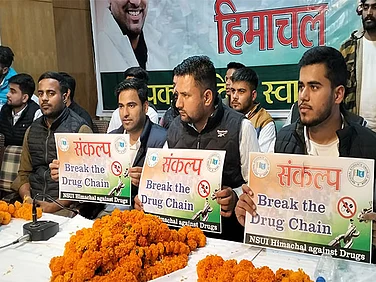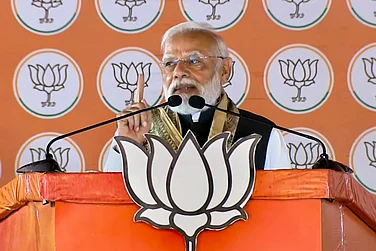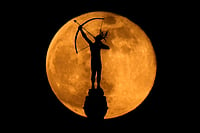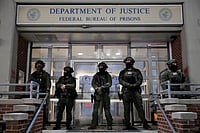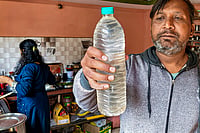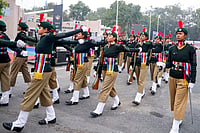Urmila Tadvi, a resident of Kevadia village, is sifting rice from husk outside her humble mud and brick home in what is now called ‘Ekta Nagar’. While most women in her village are busy campaigning for the leaders contesting from Nandod seat in Narmada district or attending poll rallies to hear what this year’s contenders had to say, Urmila says she has no interest in elections. “My husband works at construction sites on a daily wage basis. He has not found work for some time,” she says. For lunch, she and her two daughters, aged eight and 12, will eat the rice with some dal and gourd that she had grown on a patch of land that her family had left in the backyard. “The government now wants to take this land away too,” Urmila rues.
Urmila’s family is one of the hundreds of Adivasi households living in the six tribal villages of Kevadia, Limbdi, Vagadia, Navagam, Gora, and Kothi, directly affected by the construction of the Statue of Unity. They have paid the price of so-called ‘development’ without receiving any share of it in return. They are, in fact, dispossessed by it.
“My husband used to be a farmer but most of our farms are now gone,” Urmila adds. When the 182 m tall statue of Congress leader, Sardar Patel, was built, those in the area had been promised jobs and the benefits of tourism. But the residents claim that the project delivered none of that. “Only a handful from the villages have managed to get jobs. Most work as sweepers or cleaners,” Narendra Tadvi states. Urmila herself was employed as a sweeper at the Statue of Unity for a monthly pay of Rs 7,000. “They haven’t had work for me for over three months now,” she says.
While the area around Kevadia and the other villages has seen rapid development and construction work with several hotels and restaurants springing up since the statue was built, residents claim that there are barely any healthcare or education facilities available.
“There is only one primary school in the area where our kids go. Students in Class 6 and above have to travel about 10 km to Garudeshwar,” Anil Tadvi, a local guide at the Sardar Sarovar dam, said. “They built the statue in eight years. Every day, they are selling nearby lands to big hotels and companies. Yet they can’t build a school or re-touch the broken aanganwadi centre,” Anil added.
The locals have harboured seething discontent against the ruling party as well as the opposition. “When Modi, or a BJP leader, comes here, the police barricade our villages and don’t let us near the venue. On stage, they give lectures about Adivasi rights and what they are doing for tribals. In reality, all they want is our land. They don’t even know we exist,” Shailendra Tadvi, sarpanch of the nearby Vagadia village, added. The Congress, which currently ruled the Nandod seat, has remained unresponsive to the villagers’ demands regarding compensation and other issues that arose due to the Statue of Unity project.
The protests among the tribals of Kevadia, the spot for Modi’s pet vanity project, are a sore thumb sticking out in the otherwise rosy image of ‘vikas’ in Gujarat. Yet it isn’t the only move that has landed the BJP on the wrong side of the Adivasis in the state in recent times.
Earlier in the year, another ‘development’ project, the Par Tapi Narmada linkage project, pushed by the BJP in southern Gujarat faced intense protests by tribal organisations and communities. The protests forced the government to concede to the Adivasis’ demands and give up the project, which threatened to displace several villages in its path in the Dang and Valsad districts. Anger continues to simmer among large sections of the Adivasi population, which form a sizeable chunk of the voter base in Gujarat.

There are 27 seats reserved for the ST community in Gujarat and a majority of them have been Congress bastions. In 2017, the Congress party won 17 of these seats. Today, the BJP controls 13 of them. With the entry of the AAP, however, the contest has turned triangular in several seats where the AAP has given tickets to key leaders formerly with the Bharatiya Tribal Party (BTP) and its sangathan arm, the BTS.
Dressed in a white shirt and dhoti, his hair slicked back into a neat parting, BTS founder Chotubhai Vasava sits at the head of the gathering of chairs facing him, and greets the villagers and townsfolk who approach him with a reverence reserved for kings. They kiss his hand and touch his feet and he tells them all will be taken care of.
Behind him, a whitewashed wall displays a frayed a poster of the BTP, founded by Chotubhai in 2017 to consolidate the Adivasis of Gujarat under a singular political identity. That year, the BTP, which contested its maiden elections in alliance with the Indian National Congress, managed to win two seats. A former JD(U) leader and a seven-time MLA from Jhagadia, Chotubhai continues to exert considerable influence in the tribal belts of Bharuch and Narmada.
This time, however, as Chotubhai gears up for his eighth electoral venture ahead of the 2022 Gujarat Assembly Elections, the BTP looks all but finished. In tribal districts hitherto with the Congress, the BTP is now fighting a new entrant, the AAP.
“Wo adiviasiyon ke sar se pagdi hata kar unhe topi pehna rahe hain,” (‘They are removing the Adivasi turbans and making them wear caps’) Chotubhai persisted.
The bitterness follows the falling out of AAP and BTP, which had formed a much-hyped alliance in the tribal regions, ahead of the elections in September. The BTP had at the time accused Arvind Kejriwal of side-lining Chotubhai and usurping its power and influence in tribal areas. AAP had instead floated rumours of the BTP being under pressure by the BJP.
The party is set to give a tough competition to both BJP and Congress in seats like Dediapada in Narmada district where it has fielded influential former BTP leader Chaitar Vasava. Many in the neighbouring villages in Nandod and Bharuch as well as analysts in Gujarat claim that Chaitar Vasava is a clear win. “If there is only one seat that the AAP wins in Gujarat, that will be Chaitar Vasava,” Ravi Tadvi, a social activist and Nandod local, tells Outlook.
It is said that Chaitar Vasava’s popularity caused Mahesh Vasava, BTP President and son of Chotubhai, to not contest from Dediapada that Mahesh won in 2017, leading to an alleged family feud after Mahesh chose to contest from Jhagadia, his father’s seat, instead. While Mahesh has withdrawn his candidacy altogether now to support his father, Chotubhai is contesting as an independent this time.
“I don’t need any labels or name of a party to win. The people are with me, they vote for me because of my work,” he declares, adding that the BTP is still his party and it will improve vote share this year.
In the little hamlet of Mota Pipariya in Nandod taluka of Narmada district, 80 km from Jhagadia and 200 km from Ahmedabad, former Professor of Psychology, Prafull Vasava, is a known face. Associated with the Kevadia Bachao Andolan in 2016 when construction work for the Statue of Unity project started, Vasava has been a vocal critic of the BJP government and its ‘development’ projects in the area. “There are 72 villages in Nandod taluka. A majority of them have been impacted by development and vanity projects of the government,” Vasava said. “Despite protests and demands of the affected, predominantly tribal population, both Congress and BJP have remained silent about the issues of Adivasi rights,” Vasava adds.

The leader, however, sidesteps the BTP question. “I was never actively in BTP”. Vasava has been canvassing and campaigning in the villages affected by the Statue of Unity development and tourism projects where AAP has managed to build a local supporter base. Villagers from Limbdi and other nearby areas have been campaigning for AAP.
“We want Arvind Kejriwal in Gujarat,” an enthusiastic Narendra Tadvi from Kevadia village tells Outlook. “Both Congress and BJP have taken away Adivasi land for development that only helps the rich,” Tadvi adds. “We want change”.
The Congress, however, is relying on legacy. The party, which remains an influential force in the tribal seats, seems confident of retaining the tribal seats. “We will get 20-22 seats this time,” an over-confident Vansda MLA, Anant Patel, tells Outlook.
Countering AAP’s focus on PESA, Patel says, “We have been demanding implementation of PESA long before the AAP. They are not bringing anything new to the table,” he added. Patel adds that the AAP’s strategy to take over existing BTP leaders may have helped the party register themselves in media narratives but on the ground, it’s still the Congress working for the tribal population”.
Patel, a key leader heading the protests against the Par Tapi Narmada linkage project, says, “The protests shook the government from its slumber and showed them the power of the Adivasi samaj,” The campaign brought together several Adivasi organisations that work on the ground with local populations including Adivasi Samantha Samaj and Adivasi Sammanway Sastha.
Electorally, Congress stands to lose its vote share in case AAP performs well. Analysts, however, predict a three-way fight between AAP, Congress and the BJP. “BJP now controls 13 constituencies. It has grown its local voter base in rural areas, whether through the Van Kalyan work spreading Hindutva propaganda or phantom ‘development’ projects like building roads and bridges where they are not needed,” former SUCI comrade and journalist, Laxman Bagul, tells Outlook.
At a recent poll rally in tribal-dominated Chota Udepur, PM Modi attacked the Congress party for allegedly being oblivious to the existence of tribals and said the Adivasis cannot expect the Congress to improve their condition because leaders of the Congress mock tribal outfits and insult tribals. But the fear that the BJP might encroach upon the Adivasi rights of ‘Jal Jungal Jameen’, a line that party leaders like Congress’ Anant Patel have attempted to defend, even without the party’s explicit support, may cost the BJP in these seats. Other issues faced by tribals in areas like Chota Udepur include urban migration and water shortage. “Despite the ‘Har Ghar Nal’ scheme, several homes in tribal villages of Chota Udepur and Godhra region remain without water, Anandiben, a resident of Chota Udepur, tells Outlook.
And yet, in the remote village of Sunda in southern Gujarat, the promises of unemployment benefits, free healthcare and Rs 1,000 for women seemed to find some resonance among Adivasi women. 28-year-old Himaniben who worked as a seamstress in the village, said that the monthly cash benefit could help her with her business.
“We are fighting for the strict implementation of the PESA Act that can help tribals realise their rights,” Sunil Gamit, a former social worker and advocate and AAP’s candidate from Dang, tells Outlook.
Under the PESA Act, Scheduled Areas are those referred to in Article 244(1), which says that the provisions of the Fifth Schedule shall apply to the Scheduled Areas and Scheduled Tribes in states other than Assam, Meghalaya, Tripura, and Mizoram. The Fifth Schedule provides for a range of special provisions for these areas.
“We are also focusing on employment which is a big issue in tribal districts. In Dang, for instance, a majority of the working population migrates to Maharashtra for six months to work in sugarcane factories as there are no jobs available locally,” Gamit states, claiming that the AAP will push for creating employment within Dang, known for its commercial teak forests. “Creating a market for manufacture and sale of wood products in these villages can be a gamechanger,” he adds.
The coming of more political players in the tribal landscape of Gujarat however has left many worried about representation and appropriation. Ravi Tadvi, who is from Vagadia village about 2 km from the Statue of Unity, tells Outlook that the village had boycotted the elections. Many in the Tadvi samaj, for instance, have expressed displeasure that though all parties were vying for the Tadvi samaj vote, none has chosen a Tadvi candidate in the Narmada district where it forms the largest tribal community.
“These are all ways to divide the Adivasi vote bank by political parties and all of them want to exploit the population for electoral gains,” Adivasi author and Bhilistan activist, Lalubhai Vasava, contended. “Adivasis can only become a true political force when they form their own parties and take control of their own narratives”.
Shailendra Tadvi, Vagadia sarpanch, said that the elections were a farce. “No party will work for the land and compensation issues that we face. There is no water for irrigation and barely any farms left. The youth have no jobs. Our village is not digitised so we don’t get any benefits of government schemes. Why should we vote, then?” Shailendra asks. With the setback to parties like the BTP and growing religious and socio-economic stratification within the Adivasi community, the prospects of the proverbial Adivasi third front, however, remain distant.
(This appeared in the print edition as "Breaking The Tribal Vote")
(This story is part of a two-part series on tribal identity politics in Gujarat in the run-up to Gujarat Assembly Elections 2022. Read the other story here)
Rakhi Bose in Kevadia






